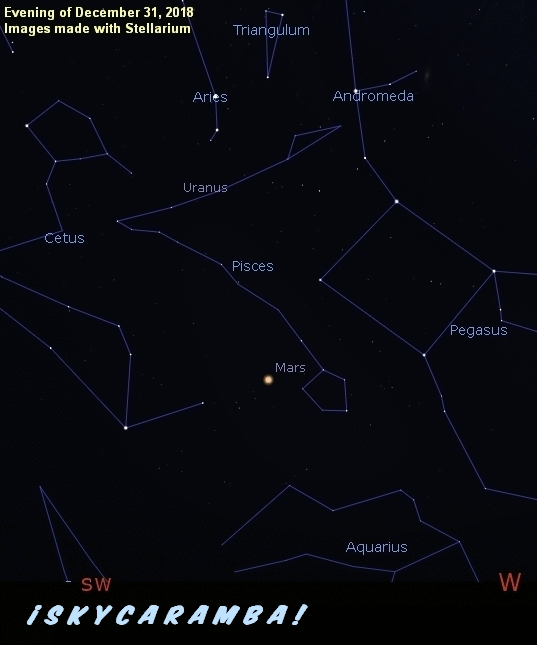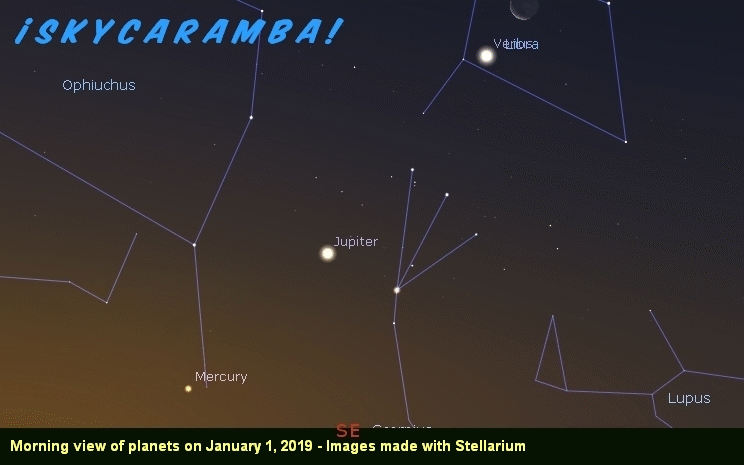Our new year starts with Mars on the meridian at sunset while Orion is rising. Venus is a morning object in Libra. Jupiter rises a little later below it. Mercury rises later still closer to sunrise. Saturn is too close to the sun to see.

Mars starts 2019 below the head of the southwest fish in Pisces. The moon passes by it on January 12. By the start of February, the red planet has moved into the region between the two fish close to where they’re tied. When the moon passes by again on February 10, Mars is crossing the northeastern fish. During the rest of the month and into the middle of March, it will move between Cetus and Aries. The moon visits Mars again on March 11. The red planet’s motion eastward continues. By the end of March, you can see it’s poised to pass east of the Pleiades in early April.
The new year starts with a Venus-moon pairing. The thin, waning crescent is in the Libra diamond with the goddess planet on the 1st. On the second morning of the year, the moon is clearing away from Libra while Venus is passing just south of Zuben Elakrab. Around the 11th, it’s passing north of Akrab in Scorpio and it’s clear there’ll soon be a rendezvous with Jupiter. Look for the two planets to be close around January 21st, 22nd, and 23rd. The moon passes by Jupiter and then Venus on the 31st.

As February starts, Venus is moving eastward toward the teapot lid of Sagittarius. Another rendezvous is imminent. After passing by Polis on the 6th, Venus passes by Saturn and the star Albaldah on the 18th and 19th. Then, Venus leaves the ringed planet behind.
On March 1, a waning crescent moon passes by Saturn. The next morning, it’s near Venus and still close (but on the other side) on the 3rd. Passing through Capricornus, Venus keeps moving toward Aquarius in the late part of the month. By this time, northern hemisphere observers are having to watch not long before sunset to spot Venus. Some may notice that Mercury is in the morning sky, almost ready for pairing with Venus in April.
More about Jupiter’s movement during the quarter: The big planet and Antares make a nice pair before dawn as 2019 begins. It makes it to the base of Ophiuchus below the star Sabik by mid-February. At the end of March, Jupiter is approaching Sagittarius from the west. Saturn is plainly visible on the other side of the constellation.
But Sagittarius and Saturn spend a couple weeks at the beginning of the year not visible because they rise with the sun. It’ll be easier to spot Mercury when a very thin, waning, crescent moon passes by it on the morning of January 4th. The messenger planet is moving sunward, so it’s not easily seen much after that. That’s okay. Saturn replaces it in the dawn in the second half of January.
While Saturn slowly moves eastward, it stays just east of the archer constellation in February and March. On February 1st and 2nd, the moon is in the neighborhood. The aforementioned pairing with Venus happens around the 18th.
And then March begins for Saturn with another visit by the moon which will pass Saturn again on the 28th and 29th.

Mercury penetrates the evening sky in mid and late February when it’s by the head of the western fish in Pisces. Mercury is returning to the morning sky at the end of March.
Some meteor showers to watch for during the quarter: the Quadrantids around January 4, the Alpha Centaurids around February 8, and the Gamma Normids around March 15.
There will be a partial solar eclipse on January 6.

There’ll be a total lunar eclipse on January 21.

The March equinox will be on the 20th at 21:59. Mars will have its northward equinox just days later on the 23rd.
Moon phases during the quarter:
New First Quarter Full Moon Last Quarter
Jan. 6 at 01:29 Jan. 14 at 06:46 Jan. 21 at 05:17 Jan. 27 at 21:11
Feb. 4 at 21:04 Feb. 12 at 22:27 Feb. 19 at 15:54 Feb. 26 at 11:28
Mar. 6 at 16:05 Mar. 14 at 10:28 Mar. 21 at 01:43 Mar. 28 at 04:10
Lunar positions during the quarter:
Southern lunistice Northward Crossing Northern Lunistice Southward Crossing
Jan. 5 Jan. 13 Jan. 19 Jan. 26
Feb. 2 Feb. 9 Feb. 16 Feb. 22
Mar. 1 Mar. 8 Mar. 15 Mar. 21
Mar. 28
Lunar perigee and apogee during the quarter:
Apogee & Perigee
Jan. 9 at 406,200 km
Jan. 21 at 357,400 km
Feb. 5 at 406,600 km
Feb. 19 at 356,800 km
Mar. 4 at 406,300 km
Mar. 19 at 359,300 km
Earth is at perihelion on January 3. It is about 147 million km from the sun. Mercury is at aphelion on January 12 at adistance of 69.9 million km. Mercury’s perihelion occurs on February 25 at 45.9 million km.
Venus is at greatest elongation, 47.0 degrees west of the sun in the morning sky on January 6.
Mercury is at greatest elongation, 18.1 degrees east of the sun in the evening sky on February 27.
